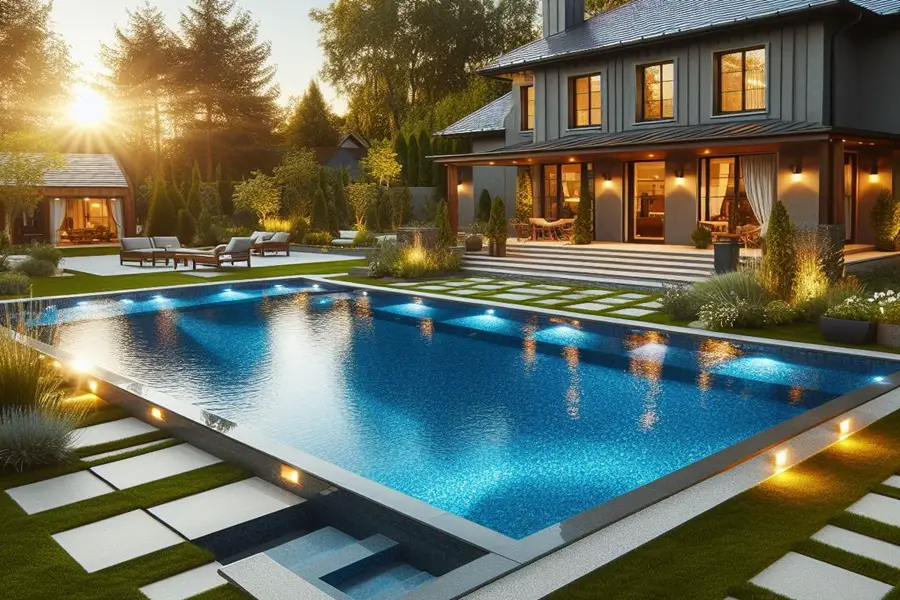Having a swimming pool at home ensures ultimate relaxation and refreshment on hot, sunny days. In addition, pools enhance the overall aesthetic of any house.
Plaster is a common material used to construct pools and is a cost-effective alternative to gunite. Plaster is relatively low maintenance, while also durable with a lifespan upwards of 15 years.
Usually, pools get filled right after finishing the surface. However, when it comes to heating pool after plastering, there are a few precautions.
Keep reading to know more about when to heat the pool after plastering and what would happen if it was heated too soon.
When to Heat Pool After Plastering?
It’s not recommended to turn the pool heater on until after the plastering is cured. At least make sure there’s no more plaster dust before heating the pool.
Curing may take anywhere from ten days to a month, but it’s critical to follow professional advice from the installer or manufacturer.
As part of the startup procedure, it’s often best to let the plastering cure for a whole month before attempting to heat the pool.
What Is the Startup Procedure?
Following an appropriate startup procedure after plastering will help ensure success. The startup process includes the duration you should care for newly finished pools after they’re filled with water.
During the curing period of time, you need to do the following regularly:
- Maintain chemical balance
- Test the water’s pH, Calcium hardness, total alkalinity, chlorine, and cyanuric acid levels
- Avoid using any automated equipment
- Brush the pool to remove plastering dust
Risks of Heating the Pool Too Soon After Plastering
So, why not start heating the pool immediately after plastering? What could possibly go wrong?
As mentioned before, plastering takes about a month to cure. So, rapid changes in the water temperatures can affect the curing process.
Additionally, heating the pool too soon not only poses risk to the plaster, but also the pool equipment.
For instance, plaster dust can scale the heater and could eventually cause failure of the unit. Warmer temperatures can also cause off-gassing in the water that could increase the water’s pH levels, which may result in mineral build-up on the heater..
Other Plastering Precautions
Aside from avoiding heating the pool, there are a few more things to avoid for at least 28 days after plastering your pool. Here are some tips to consider:
- Don’t swim until the pool’s water is completely balanced.
- Don’t shock the pool during the first month.
- Don’t use any devices with wheels, as they might damage the plastering.
- Don’t use any saltwater generators.
- Don’t use chemical feeders other than pH Controllers and Oxidation Reduction Potential (ORP).
- Don’t use automated cleaning devices whether robotic or built-in, as they might get clogged due to the plastering dust.
What to Do After Plastering the Pool?
After the plastering is complete, you should immediately start filling the pool with water. Don’t let the pool dry out before it’s completely submerged, as this could cause cracking and other issues..
Filling the pool may take up to 36 hours. Once you start the filling process, don’t stop under any circumstances until the pool is completely full to avoid the formation of any water lines.
If you’re using water trucks to fill the pool, make sure to start with 24 inches of water as a cushion before operating the trucks.
Here’s what you should do:
- Use an ordinary garden hose to fill the pool by placing it on the deepest side of the pool.
- Attach a water bottle to the end of the hose to help it float and not damage the plastering.
- Don’t allow any person or pet into the pool. A newly plastered pool is prone to forming footprints or pawprints.
- Test the water for alkalinity, pH, metals, and calcium hardness using a test kit and adjust the chemical levels.
- Don’t forget to track the process and record the testing results.
Also, make sure to brush the pool surface after filling it at least twice a day until there’s no dust left. This way, you get to maintain the fresh appearance of the pool finish.
After 28 days
After the first 28 days, you should continue to monitor and maintain the pool water balance by regularly testing and adjusting the chemicals.
You should also maintain the Langelier Saturation Index (LSI) between 2.2 and 0.3 after the start-up procedure has been completed.
That’s because negative LSI levels cause discoloration, etching, and leaching. On the other hand, positive levels cause scaling and discoloration.
Final Takeaway
Although plastering the pool is a sure way to provide a fresh, new, and sparkling look, there are some precautions related to the process.
Heating the pool after plastering isn’t recommended. So, you should wait until the plastering is completely cured and the dust is gone before turning on the heater.
Once it’s all done, you can consider heating up your newly-finished pool. Just remember to double-check that you’re following all appropriate instructions from the installer!
Happy Swimming!
Husband and father of three (actually, four if you include the pool). I’m an avid DIY-er and weekend warrior that enjoys taking up new projects around the house to help us maximize leisure right at home. I enjoy researching and sharing various tips, tricks and knowledge to help others make their home an oasis.

